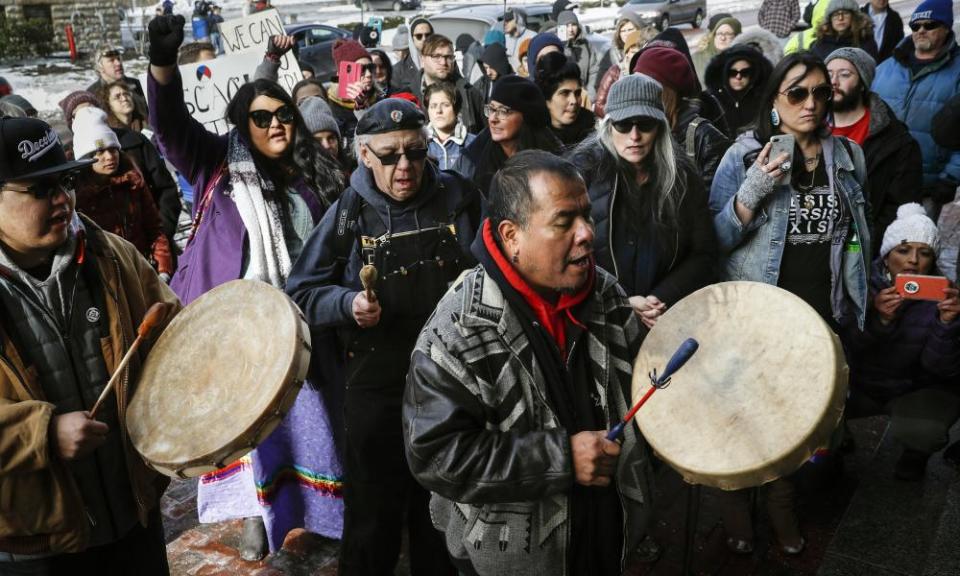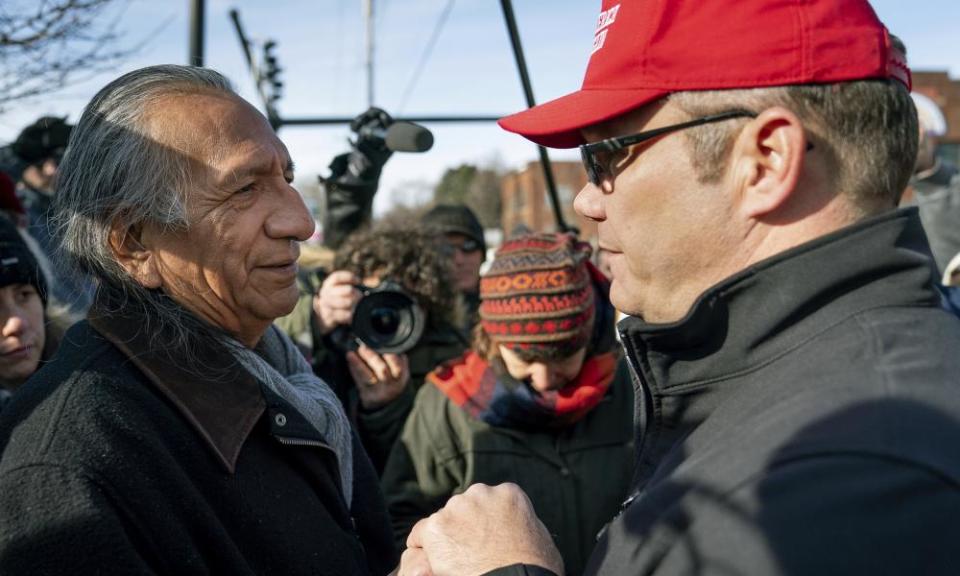Controversy over students mocking Native American strikes national chord
The spectacle of a crowd of white teens in pro-Trump caps mocking a Native American activist on the National Mall just days before Martin Luther King Jr day was perhaps not needed to demonstrate that America’s social fabric is stretched thin.
The explosion of a media controversy around the incident was probably not necessary to drive participants in the ensuing debate into their usual partisan crouches.
And the role of an apparent imposter Twitter account in originally pushing video of the confrontation to go viral was not required to underscore how vulnerable the national dialogue still is to social media hijacking, less than two years out from the 2020 elections.
But those elements combined help to explain why the showdown on the Mall between Covington Catholic high school students demonstrating against abortion rights and two other groups has struck a national chord, with reverberations in culture and politics amplified by an aggressive entry into the argument by Donald Trump himself.
“The students of Covington have become symbols of Fake News and how evil it can be,” Trump tweeted on Tuesday. “They have captivated the attention of the world, and I know they will use it for the good – maybe even to bring people together. It started off unpleasant, but can end in a dream!”
It was unclear whether Trump intended to echo King, who delivered his “I have a dream” speech at the very site of the clash, on the steps of the Lincoln Memorial.
Trump’s sure intent, however, was to vindicate the racist and mob-like conduct of some students in the affair by pointing out, as Fox News had already done, that early video of the incident did not capture a previous war of insults at the scene between the Covington students and a small group of confrontational African American evangelists called the Black Hebrew Israelites.

Opinions diverge – along ideological lines, of course – on whether full-length video of the scene cast the students’ conduct in a different light. The video does capture a moment in which a student takes off his shirt and leads his classmates in a chant, which they heartily join, in the style of a football cheer, or a Trump campaign rally.
“In this case the facts happened to support the rightwing tribe,” wrote the conservative New York Times columnist David Brooks.
On the contrary, wrote Josh Marshall of Talking Points Memo, watching every available video “doesn’t greatly change the substance of what you see on the video, which is a middle aged Native American activist/elder beating a ceremonial drum in the face of what appears to be a bemused and cocky teenager while his classmates surrounding them, mostly wearing Maga caps, jeer and taunt the man with chopping motions.”
Maga: Make America Great Again. The northern Kentucky county where Covington Catholic is located voted for Trump by a 26-point margin. It is also in the heart of a region on the radar of the Southern Poverty Law Center for its proliferation of hate groups, including white supremacist and radical Christian identity groups.
After originally censuring the students and vowing consequences, Covington has in recent days deployed media surrogates to defend itself, to argue that the students were not at fault, and their actions on video had been misunderstood.
In a strong indicator of the political undertones of the argument taking shape, the school’s public relations firm is closely tied to Mitch McConnell, the senate majority leader from Kentucky, noted Democratic strategist Adam Parkhomenko.
In a national television interview broadcast on Wednesday morning, the student at the center of the spectacle, Nicholas Sandmann, repeated a claim he made Sunday, that he was trying to defuse the situation, wearing a smile of silent prayer, not a condescending smirk, as he stood nose-to-nose with Omaha tribe elder Nathan Phillips.
The forensic, and remarkably sharp, debate over what the video exactly shows is another typical feature of the national moment. Trump began his presidency by asking people not to believe photographs showing that his inauguration drew a relatively small crowd. More recently, Trump claimed that he had never said that Mexico would pay for a border wall, despite miles of video evidence to the contrary.
The loud disagreement between the political camps over whose side the evidence is on seems unlikely to resolve itself soon. But after a presidential election in which the pernicious influence of imposter social media accounts has been widely documented, the question of exactly who is goading the two sides to battle seems worthy of examination.

The original viral Covington video was spread by a Twitter account called @2020fight, a new account with tens of thousands of followers that specialized in incendiary but ideologically inconsistent political content and was attributed to a “teacher” from California, despite using the photograph of a blogger from Brazil.
Twitter suspended the account on Tuesday. While there are currently no solid indications of who was behind the account, said Clint Watts, a research fellow at the Foreign Policy Research Institute, the account’s tactics and patterns are reminiscent of the 2016 social media election tampering campaign.
“It still shows the power of inauthentic social media manipulation,” said Watts. “It’s dividing us. It doesn’t bode well for 2020.”
Bernice King, daughter of the civil rights icon, was among the Twitter users to post the viral video.
“We are not a post-racial or post-racism nation,” she wrote. “Courageous people, like this Native elder, face overt racism and racist ideologies and systems each and every day. This is ugly, America. Truth, education and corrective action matter.”
“America has cowered in the drudgery of racism and bigotry for 400+ years,” she continued.
“Colonialism and white supremacy have violently shaped systems, including education, across the globe.
What we teach NOW matters.
Our children are influenced by the hate OR the love we give.
Choices.”

 Yahoo News
Yahoo News 
